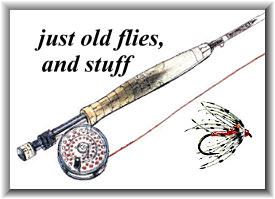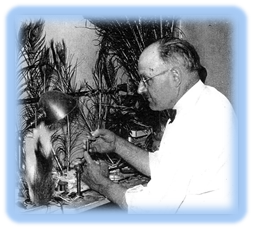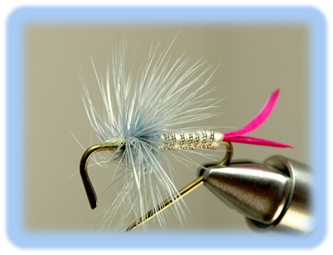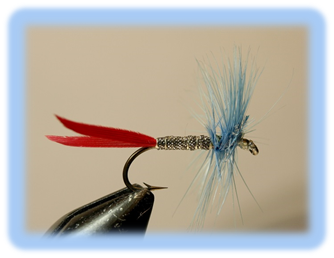
Welcome to 'just old flies,' a section of methods and flies that used-to-be. These flies were tied with the only materials available. Long before the advent of 'modern' tying materials, they were created and improved upon at a far slower pace than today's modern counterparts; limited by materials available and the tiers imagination.
Once long gone, there existed a 'fraternity' of anglers who felt an obligation to use only the 'standard' patterns of the day. We hope to bring a bit of nostalgia to these pages and to you. And sometimes what you find here will not always be about fishing. Perhaps you will enjoy them. Perhaps you will fish the flies. Perhaps?
THE HISTORICAL "VICTORY FLY" - America's icon fo patriotism
 When America declared war on Japan, Art Winnie responded with his symbol of patriotism … the 'Victory Fly', first created in late 1941, and shortly thereafter debuted in the Grand Rapids Press on February 7, 1942.
When America declared war on Japan, Art Winnie responded with his symbol of patriotism … the 'Victory Fly', first created in late 1941, and shortly thereafter debuted in the Grand Rapids Press on February 7, 1942.
Art who was taught fly tying by his brother Bert, owned a barber shop in Traverse City, Michigan. He became one of Michigan's famous tyers of early Michigan fly patterns, while Bert pursued his career as a renowned creator of fishing decoys. Both Art and Bert had well established reputations in their respective careers among fishermen.
Art's first rendition of the Victory fly was tied on a dry fly hook, most probably a 6XL. It had a tail of two red duck quills tied in a 'V', a body of white silk floss ribbed with Gudebrod HT Braid (silver/black). The fly was extremely colorful with large wings tied in a 'V' shape … 'V' for victory! The wings were red, white and blue. I have it on good authority that the wings were 'married': different colored feathers were laid one upon another to achieve the effect of a single multi-feathered wing. This technique is often used by streamer and salmon fly tyers. It demands a lot of skill, a tremendous amount of time and is often costly.
 This representation does not have married wings (I lack the skill required to do this). I have used permanent markers to attempt to at least demonstrate what the fly most probably looked like. I reconstructed it from the photograph that appeared in the original article in the Grand Rapids Press. It is my position that the 'original' Victory Fly was nothing more than a fancy prototype prepared solely for the press. It was simply too time consuming and expensive to mass produce. Art was doing this for a living; his livelihood depended on tying and selling large
quantities of flies. This fly was not economical to produce.
This representation does not have married wings (I lack the skill required to do this). I have used permanent markers to attempt to at least demonstrate what the fly most probably looked like. I reconstructed it from the photograph that appeared in the original article in the Grand Rapids Press. It is my position that the 'original' Victory Fly was nothing more than a fancy prototype prepared solely for the press. It was simply too time consuming and expensive to mass produce. Art was doing this for a living; his livelihood depended on tying and selling large
quantities of flies. This fly was not economical to produce.
Representation of the original Victory Fly
 The broach variation of the Victory Fly was easily tied and very popular with the public. It was designed so that the pin-backed fly could be worn on a suit lapel, hat or dress. The tail, body and rib are identical to the original prototype but the wings have now been replaced with a blue hackle collar. The fly was tied without a head. President Franklin D. Roosevelt (along with his Cabinet) is said to have worn this pin on his lapel on more than one occasion.
The broach variation of the Victory Fly was easily tied and very popular with the public. It was designed so that the pin-backed fly could be worn on a suit lapel, hat or dress. The tail, body and rib are identical to the original prototype but the wings have now been replaced with a blue hackle collar. The fly was tied without a head. President Franklin D. Roosevelt (along with his Cabinet) is said to have worn this pin on his lapel on more than one occasion.
Tied by Art Winnie
 The third variation of the fly was actually tied for the fisherman. The recipe is the same as the above except that the body was wrapped with very heavy ribbing. The underbody material (white silk floss) is barely visible.
The third variation of the fly was actually tied for the fisherman. The recipe is the same as the above except that the body was wrapped with very heavy ribbing. The underbody material (white silk floss) is barely visible.
Once again, the fly was tied without a head. In Art's own words, "This Victory fly is going to be a killer. German browns won't like it --- but it'll hook 'em every time."
Tied by Art Winnie
Art Winnie (1860-1966) was one of Michigan's most historic fly tyers having created other famous Michigan patterns including the Michigan Hopper and the Michigan Caddis. His original patterns are no longer tied or fished with, but some of his variations live on. The 'Victory Fly' vanished when the war ended, having lived for only a brief period of glory in the annals of history.
See you on the water…..
Tom Deschaine
~ www.michigandryflies.net ~
Copyright2013©Deschaine
I owe a special note of thanks to Mr. Gary Miller who inspired this article by providing me with a
copy of the original article from the Grand Rapids Press. The Art Winnie photograph was provided
from his photo collection. He also allowed me to photograph his broach fly tied by Art Winnie.
[ HOME ]
[ Search ] [ Contact FAOL ] [ Media Kit ]